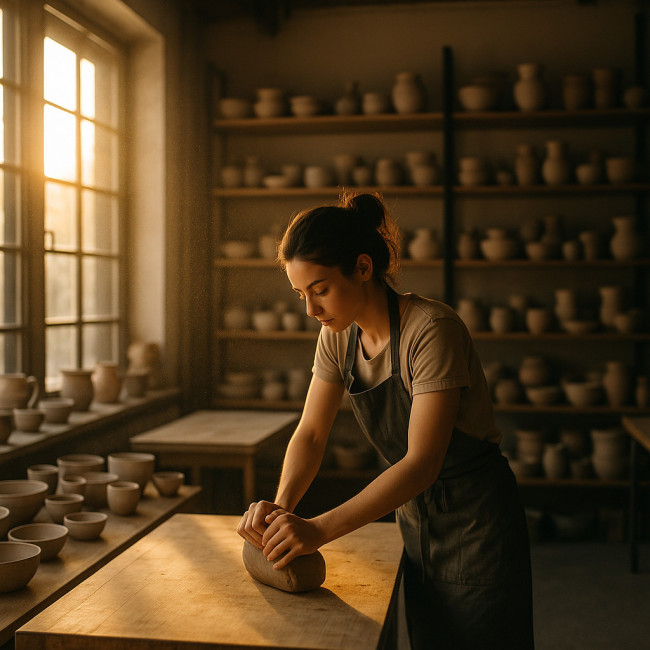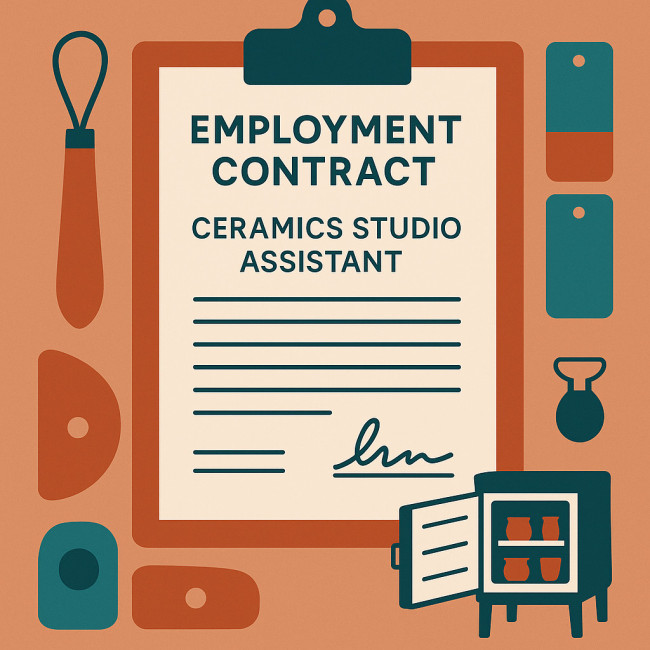Ceramist studio assistant roles: duties, pay ranges and contract essentials
Thinking about becoming a ceramist studio assistant — or hiring one? This guide unpacks daily duties, realistic pay ranges and the must-have clauses every contract should include. Walk away knowing exactly what value a studio assistant brings, how to budget for the role and how to future-proof your working relationship.
Why modern ceramics studios rely on assistants

Ceramics has surged in popularity over the past decade. Small studios suddenly face wait-lists, wholesale orders and ambitious capacity benchmarks. A skilled ceramist studio assistant allows lead artists to stay focused on design innovation while day-to-day production keeps flowing smoothly. From spiral wedging marathons to late-night kiln unloads, assistants keep the creative engine humming across every square meter of the dusty workshop, ensuring that artistic vision translates into tangible, sellable ware without bottlenecks.
- Productivity: Assistants handle repetitive prep so the kiln never sits idle.
- Quality control: Extra eyes catch glaze drips or hairline cracks before shipping.
- Client experience: Faster turnaround and pro-level packaging build brand trust.
Core duties of a ceramist studio assistant
1. Production workflow
- Clay prep: Wedging, reclaiming and portioning batches to recipe.
- Forming support: Rolling slabs, throwing basic forms, trimming foot rings.
- Drying & bisque monitoring: Rotating shelves, logging moisture checks, loading kilns.
2. Glaze and surface finishing
- Mixing test glazes, sieving and recording ratios.
- Wax-resist application and touch-up sanding.
- Spraying or dipping pieces under lead artist supervision.
3. Studio maintenance
- Daily clean-down of wheels, ware boards and sinks.
- HEPA vacuuming dried clay to protect lung health.
- Scheduling kiln element checks and basic tool repairs.
4. Logistics & client-facing tasks
- Packing orders with foam, corner protectors and drop-tests that meet shipping standards for fragile ceramics.
- Updating inventory spreadsheets, SKU labels and batch numbers.
- Hosting open-studio visitors and processing POS sales.
Skill set and training pathways
Most assistants hold a ceramics diploma or comparable workshop hours. Rapid learning curves come from:
- On-the-job coaching during the first 90 days. Shadowing shortens the time to independent throwing.
- Peer mentoring circles at local maker hubs or through online craft-designer communities like Artfolio's collaboration job board.
- Digital upskilling—from kiln-control software to cloud inventory tools—essential for studios scaling limited runs or exclusive editions.
How much do ceramist studio assistants earn?
Rates vary by region, studio size and task complexity. The table below reflects 2024 benchmarks for entry- to mid-level assistants working 30–40 hours a week.
| Region | Hourly floor | Typical range | Overtime premium* |
|---|---|---|---|
| United States (urban) | $17 | $20 – $26 | 1.5× after 40 h |
| United Kingdom | £10.50 | £12 – £18 | 25 % uplift |
| EU (average) | €11 | €13 – €19 | Varies by CBA |
| Australia | AUD 24 | AUD 26 – 32 | 1.5× after 38 h |
| Canada | CAD 17 | CAD 19 – 25 | 2× statutory holidays |
*Overtime premiums follow local labour codes; always cross-check state or provincial rules.
Freelance day rates
Studios with seasonal surges often book assistants on a day-rate basis. Current averages sit between USD 180 and 260/day, usually invoiced net 30 with materials reimbursed.
Contract essentials every studio assistant agreement needs

A written contract avoids scope creep and protects both parties. Below are the clauses industry lawyers flag as non-negotiable: clarifying everything from photo credits to tool maintenance responsibilities turns potential friction points into clear bullet-points. Courts in multiple jurisdictions increasingly expect artisan studios to document health-and-safety protocols, so be granular; outlining respirator checks, silica exposure monitoring and emergency shut-off procedures can safeguard both employee welfare and the company's liability profile.
Key clauses to negotiate
- Scope of work: List tasks clearly—e.g., “throw up to 40 mugs/week” or “operate kiln up to 1300 °C.”
- Intellectual property: Who owns glaze formulas or new moulds developed during employment?
- Health & safety compliance: Reference respirator fit-testing and silica exposure logs.
- Non-compete window: Reasonable if protecting proprietary tableware lines, but rarely exceeds 12 months.
- Termination terms: Notice period, payout of unused leave and hand-over of digital files.
For studios shipping collector items internationally, add insurance language aligning with glaze durability specs required by architects. This ensures replacements are covered if freight damage occurs.
Employment vs. independent contractor status
In some regions, assistants must be treated as employees if the studio dictates hours and supplies all tools. Misclassification can trigger fines, so consult an accountant before issuing 1099 or sole-trader paperwork.
Career growth: from assistant to lead ceramic artist
Many celebrated ceramists started as studio assistants. A clear progression path keeps talent engaged and reduces turnover.
- Year 1–2: Master production consistency and record kiln cycles.
- Year 3–4: Design small capsule collections sold under the studio brand.
- Year 5+: Launch independent work or move into operations management, leveraging skills from open-studio events that convert clients.
Mini-Quiz: Are you studio-assistant ready?
FAQ
- Do assistants need their own liability insurance?
- If you invoice as a freelancer, yes. Most policies start around USD 200/year and cover accidental damage and minor injuries.
- Can I negotiate royalty on best-selling pieces I help design?
- Absolutely. A small percentage (1–3 %) on net sales is common when the assistant contributes original design elements.
- How many pieces should I produce per hour?
- For wheel-thrown tumblers, 6–8 blanks/hour is a solid target once fully trained. Complex forms demand slower rates.
- Is night-shift kiln monitoring paid extra?
- Yes. Studios typically add a 20–30 % night differential or a flat on-call fee covering the full firing cycle.
- What software skills boost my hireability?
- Inventory apps like Craftybase, basic Photoshop for mock-ups and spreadsheet fluency for cost tracking.
Takeaway
A ceramist studio assistant is more than an extra set of hands; they are the backbone of consistent production and client satisfaction. Define duties up front, pay at or above industry benchmarks and lock in protective contract clauses. Do that, and both studio and assistant can focus on shaping clay into coveted work — instead of patching operational cracks.
Ready to formalise your next hire? Download our sample contract template and start the onboarding chat today.











